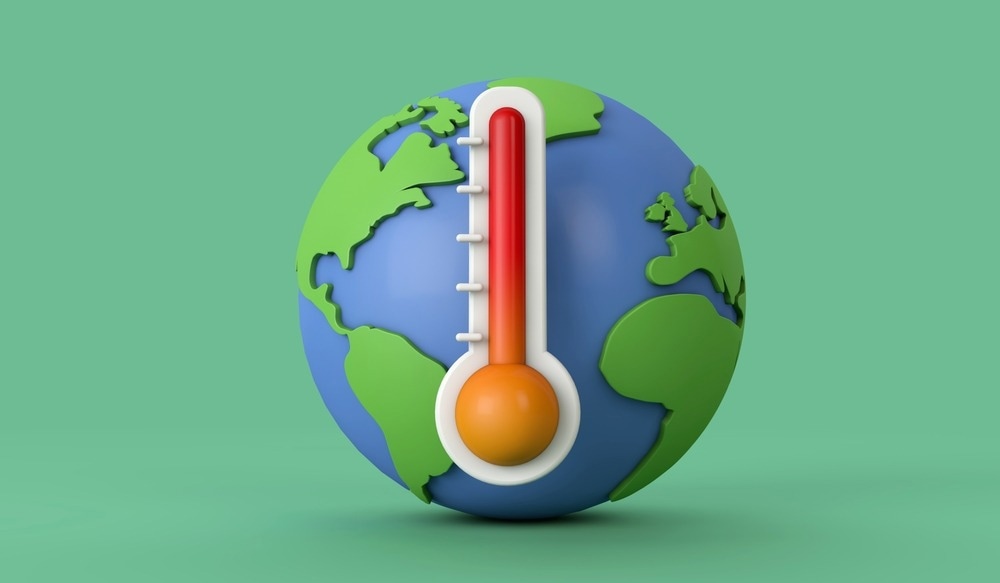Reviewed by Alex SmithJun 29 2022
At the University of East Anglia (UEA), a new study measures the advantages of restricting global warming to 1.5 °C and determines the hotspot regions for climate change threats in the future.

Image Credit: Ink Drop/Shutterstock.com
The study assesses decreases in human exposure to a range of threat-water scarcity, vector-borne diseases, and heat stress, coastal and river flooding that would restrict global warming to 1.5 °C instead of 2 °C or 3.66 °C. Also, impacts on agricultural yields and the economy are included.
Scientists from the UK, like researchers from UEA and the University of Bristol, and from PBL Netherlands Environmental Assessment Agency, determine that the threats are decreased by 10 to 44% worldwide if warming has been decreased to 1.5 °C instead of 2 °C.
At present, inadequate climate policy has been implemented across the globe to restrict warming to 2 °C, so the research group also made a comparison with threats that would take place with greater levels of global warming.
Risks will be higher if global warming is greater. The threat at 3.66 °C warming is decreased by 26 to 74% if rather than warming is kept to only 2 °C. They have decreased even additionally, by 32–85%, if warming can be limited to just 1.5 °C.
The ranges are extensive since the percentage varies on which of the indicators, for instance, human exposure to flooding or drought, are being taken into account.
The findings reported recently in the Climatic Change journal, indicate that in percentage terms, the prevented risk is highest for drought, river flooding, and heat stress. However, in absolute terms, the risk reduction is highest for drought.
Also, the authors determine India, West Africa, and North America as regions where the threats caused by climate change have been projected to increase the majority with 1.5 °C or 2 °C of average global warming by 2100.
The study tracks the Intergovernmental Panel on Climate Change (IPCC) Sixth Assessment Report, determining that global net-zero CO2 emissions should be reached in the early 2050s to limit warming to 1.5°C with no or limited overshoot and also around the early 2070s to limit warming to 2°C.
Our findings are important because the Paris Agreement target is to limit global warming to ‘well below’ 2 °C and to ‘pursue efforts’ to limit it to 1.5 °C. This means that decision makers need to understand the benefits of aiming for the lower figure.
Rachel Warren, Study Lead Author and Professor, Tyndall Centre for Climate Change Research, University of East Anglia
Warren continued, “In addition, at COP26 last year, the commitments made by countries in terms of greenhouse gas emission reductions are not sufficient to achieve the Paris goals. At present, current policies would result in average warming of 2.7 °C, while the Nationally Determined Contributions for 2030 would limit warming to 2.1 °C.”
“While there are a number of planned additional actions to reduce emissions further, potentially limiting warming to 1.8 °C in the most optimistic case, these still need to be delivered and further additional action is needed to limit warming to 1.5°C,” added Warren
For this study, the scientists ran advanced computer simulations of climate change risk, utilizing a common set of climate change scenarios in which global temperatures increase by 2 °C and individually by 1.5 °C and 3.66 °C. Further, they compared the outcomes.
The findings include:
- On the whole, exposure of the global population to dengue and malaria fever is 10% lower if warming has been constrained to 1.5 °C instead of 2 °C.
- Population exposure to water scarcity is highly evident in western India and also the northern region of West Africa.
- A constant increase in global drought risk with global warming is evaluated, with hundreds of millions of people impacted additionally by drought at each, successively higher warming level.
- By 2100 if humans do not get adapted, global warming of 1.5 °C would place an extra 41 to 88 million people a year at risk from coastal flooding throughout the world (linked to 0.24–0.56 m of sea-level increase), whereas an extra 45 to 95 million people annually would be at risk under global warming of 2 °C (corresponding to 0.27–0.64 m of sea-level increase) in 2100.
- Global economic effects of climate change are 20% lower while warming has been limited to 1.5 °C instead of 2 °C. The net value of damages is similarly decreased from 61 trillion US dollars to 39 trillion US dollars.
The study utilized 21 alternative climate models to simulate the regional patterns of climate change that are equivalent to 2 °C warming and 1.5 °C warming in a respective manner. An earlier study has used easier models, a more restricted range of climate models, or has spanned various risk indicators.
Journal Reference:
Warren, R., et al. (2022) Quantifying risks avoided by limiting global warming to 1.5 or 2 °C above pre-industrial levels. Climatic Change. doi.org/10.1007/s10584-021-03277-9.